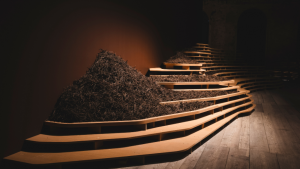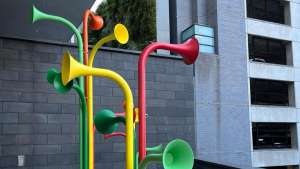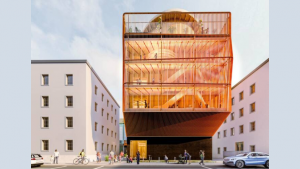In response to the growing water crisis – globally and in South Africa – the Fog Catcher has been designed with the potential to be both a functioning system of water catchment and a conceptual investigation into our relationship with vital resources, particularly water. It also effectively shows how the seemingly separate realms of environmental awareness and community upliftment can be united through sustainable design.
A prototype of the Fog Catcher is being built at the Design Indaba Festival 2017. This model serves as a sketch and introduces the conceptual concerns of the project. The design team’s longer-term intention is to roll out the Fog Catcher for functional use in rural, and potentially also in urban, water-scare areas.
Drawing on existing fog catcher designs such as those of the Warka Water project in Europe, Africa, South America and the Middle East, the Catcher works by allowing condensation to collect on the fabric. It works best when it is as high as possible from sea-level. The moisture in the fabric then drips into the collection tray and is channelled into and stored in a closed tank for future use.
This method has been used extensively in rural and agricultural areas worldwide and was introduced to one of the project designers, Kathy Ackerman Robins through her development work at Goedgedacht Farm, a community-based farm in Riebeeck West, Western Cape. For the purposes of the Design Indaba installation piece, the Fog Catcher has been adapted as an art installation and, as such, the fabric is not the exact material that would eventually be used in the functioning Fog Catcher. The intention behind the structural and material design of the Design Indaba model and the future functioning Fog Catcher was based on affordability for potential future communities in which the Catchers would be installed, where the use of low-cost and accessible materials is a primary concern.
For our model, the hessian fabric is embroidered in three colours, one of which shows the visualisation of a sound wave produced by dripping water. The second is a line graph depicting the changing water levels of the dams in the Western Cape, and the third is the number 59, referring to one of the estimates of the number of days of water remaining for public use in the City of Cape Town from the start of the Design Indaba Festival on 1 March 2017.
The Fog Catcher is currently being built by the TEN Project at the Workspace makerspace in Hout Bay – a non-profit, public benefit organisation that is dedicated to providing a platform for knowledge and skills exchange across the social, cultural and generational divides. The TEN Project was founded to help teach school leavers in South Africa from disadvantaged backgrounds the physical and emotional skills to enter the workplace. The 28-day programme run by TEN teaches solid values and skills that offer them the chance at a better life, as well as earn a living. The Workspace makerspace provides infrastructure for existing artisans, artists and tradesmen the opportunity to use their skills, while also teaching practical skills and training new artisans. The project offers resources for all people from all backgrounds, ages and abilities to use “making” as a tool for empowerment, economic opportunity and the building of social capital.
All images by Jonx Pillemer.
















